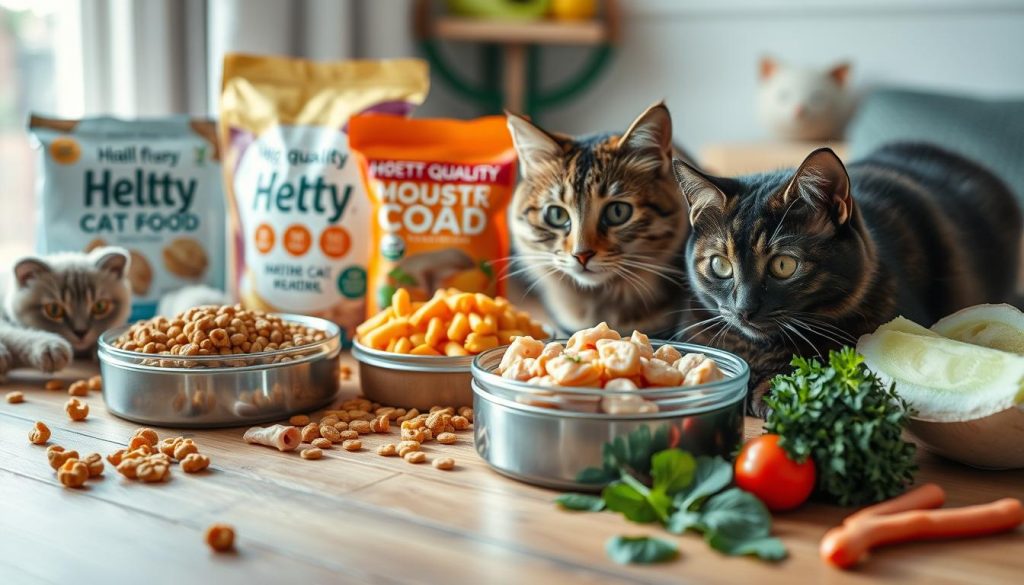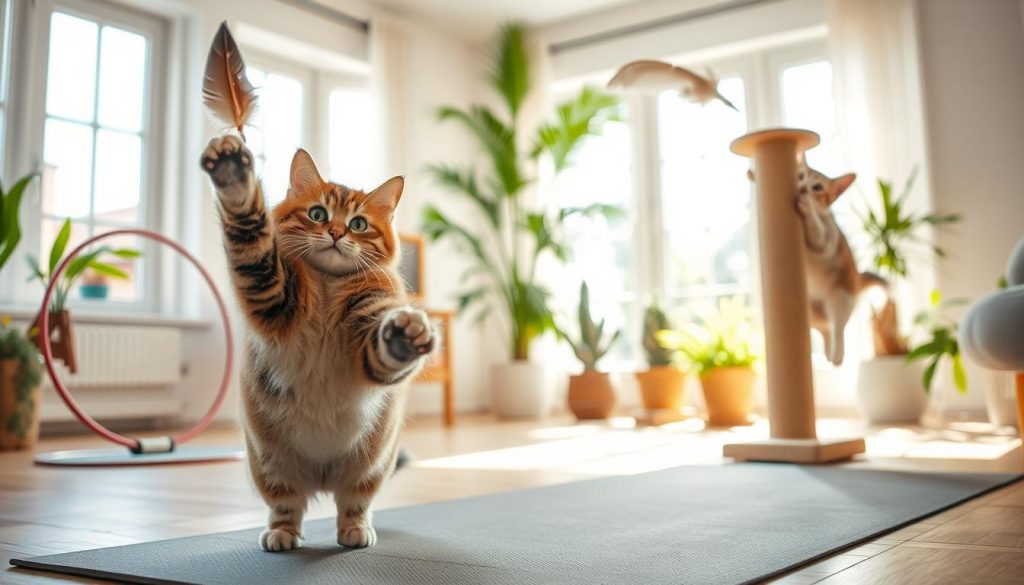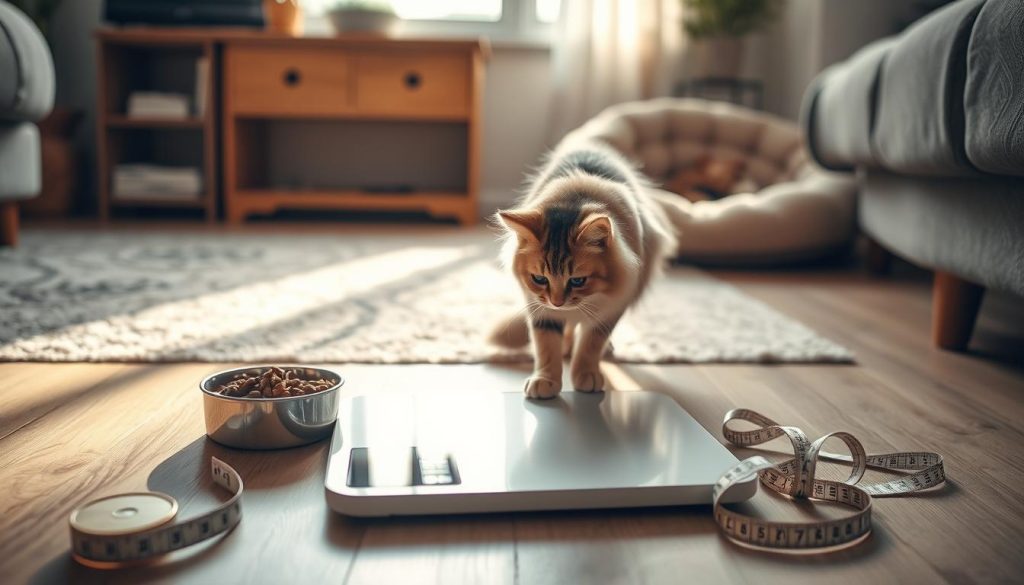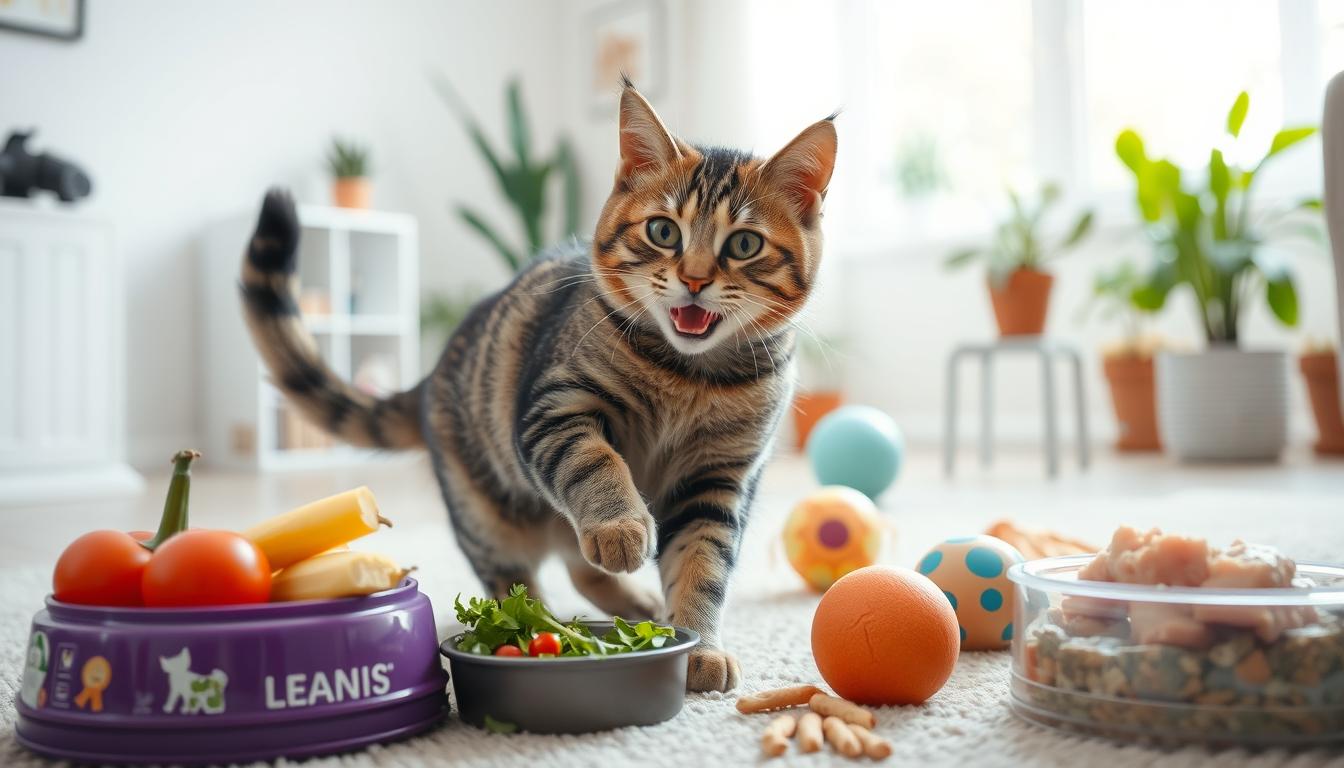As a devoted cat parent, I know how crucial it is to keep your furry friend healthy. Preventing obesity is key to their well-being. In this guide, I’ll share expert tips to help your cat stay fit and healthy.
Feline obesity is a big problem, with up to 60% of cats in the U.S. being overweight or obese. It can lead to serious health issues like joint problems, diabetes, and respiratory issues. By preventing obesity, you can help your cat live a long, happy life.
We’ll explore the risks of obesity, how to balance their diet, and create an exercise routine. We’ll also talk about monitoring their weight and health. Plus, we’ll cover the importance of environmental enrichment and overcoming weight management challenges. Let’s keep your furry friend in top shape!
Understanding the Risks of Feline Obesity
Obesity in cats is a big problem. It can cause serious health issues. Knowing the risks of feline obesity helps keep our pets healthy and happy.
Physical and Mental Health Consequences
Excess weight can harm a cat’s body. Overweight cats face joint problems, breathing issues, and diabetes risks. It also affects their mental health, causing lethargy and less activity.
Contributing Factors to Weight Gain
Weight gain in cats comes from many sources. These include bad diets, not enough exercise, and health problems. Spotting the signs of overweight cats is key. This includes fat around the belly and grooming issues. By understanding these risks and causes, we can help our cats stay at a healthy weight.
| Risk Factor | Description |
|---|---|
| Overfeeding | Too much food or treats can make cats gain weight. |
| Sedentary Lifestyle | Not enough exercise can lead to feline obesity. |
| Medical Conditions | Some health issues, like hypothyroidism, can cause weight gain in cats. |
By knowing the risks and causes of feline obesity, we can act to keep our cats healthy and active.
Establishing a Balanced Diet for Your Furry Friend

It’s key to give your cat the right diet to keep them at a healthy weight. As a pet owner, picking the right food and portion size is crucial to stop cat obesity.
Choose healthy cat food that’s full of nutrients. It should match your cat’s age, activity level, and health needs. Stay away from foods high in carbs and fillers, as they can lead to weight gain.
Controlling portion sizes for cats is also vital. Cats have smaller stomachs and different needs than humans. Always follow the food packaging’s feeding guidelines and adjust as needed for your cat.
| Nutrient | Recommended Daily Intake for Cats |
|---|---|
| Protein | 26-30% of total caloric intake |
| Fat | 9-15% of total caloric intake |
| Carbohydrates | Less than 10% of total caloric intake |
By giving your cat a balanced diet and the right portion sizes, you can help them stay healthy. This avoids the health problems linked to cat obesity.
Cat Obesity Prevention: Creating an Exercise Routine

Regular exercise is key to preventing and managing cat obesity. A well-planned exercise routine can greatly improve your cat’s health and happiness. I’ll show you fun activities to keep your cat active and tips to keep them motivated.
Fun and Engaging Activities
Cats are natural athletes. With the right approach, exercise can be fun for them. Here are some activities to add to your cat’s routine:
- Interactive cat toys: Get toys that make your cat chase, pounce, and play, like laser pointers, feather wands, and puzzle feeders.
- Vertical climbing structures: Give your cat tall cat trees, scratching posts, or window perches to climb and explore.
- Outdoor exploration: If it’s safe, take your cat on outdoor adventures to see new sights, sounds, and smells.
Keeping Your Cat Motivated
Keeping your cat excited about exercise can be tough. But with a few strategies, you can keep them engaged and motivated:
- Vary the activities: Change up the exercise routines to prevent boredom and keep your cat interested.
- Use positive reinforcement: Reward your cat with treats, praise, or playtime after exercise to encourage the behavior.
- Tailor the routine: Watch what your cat likes and adjust the activities to fit their interests and energy levels.
By following these tips, you can create a great exercise and weight loss routine for your cat. This will keep them healthy and happy.
Monitoring Your Cat’s Weight and Health

Keeping your cat at a healthy weight is key for their happiness. Regular checks on their weight and health can spot problems early. This way, you can help your cat live a long, joyful life.
Regular Check-ups with the Veterinarian
Visiting the vet regularly is vital. They will weigh your cat and check their body condition. This helps track any weight changes and suggests diet or exercise plans.
These visits also help find other health issues. Early treatment can greatly improve your cat’s life. So, it’s important to keep up with vet visits.
- Weigh your cat at home regularly to track any changes in weight
- Observe your cat for signs of overweight, such as an enlarged abdomen or difficulty grooming
- Discuss any concerns about your cat’s weight or health with your veterinarian
- Follow your vet’s recommendations for a balanced diet and appropriate exercise
By being alert and working with your vet, you can keep your cat healthy. Watching their weight and health is a big step. It helps prevent obesity and makes your cat’s life better.
Environmental Enrichment for Mental Stimulation
Providing your cat with mental stimulation is as important as physical exercise. It keeps them healthy and helps prevent weight gain. By making their environment engaging, you can fight cat boredom and obesity.
Interactive toys are a great way to keep your cat’s mind sharp. Puzzle feeders, for instance, make them think and work for food. This encourages natural hunting behaviors. Vertical scratching posts and cat trees also offer exercise and mental stimulation as they climb and explore.
- Rotate a variety of toys to keep your cat’s interest piqued and prevent boredom.
- Provide hiding spots, such as cardboard boxes or paper bags, that allow your cat to engage in their natural stalking and hunting behaviors.
- Incorporate interactive playtime with wand toys or laser pointers to encourage your cat to chase and pounce, mimicking their predatory instincts.
Creating a stimulating environment for your cat is key. It keeps them happy and healthy, reducing weight-related issues. A mentally active cat is a happy and healthy one.
Overcoming Challenges and Staying Committed
Keeping your cat at the right weight can be tough. But, with determination and a positive outlook, you can beat the odds. Cats might not want to exercise or try new foods. Start by making small changes and making meals fun. Find fun ways to get them moving.
It’s also hard to keep going with your cat’s weight plan. You might feel down if progress is slow or your cat doesn’t cooperate. Celebrate every little win, like a small weight loss or more activity. Keep track of your cat’s progress and tweak the plan as needed to stay on course.
Your cat’s health and happiness are worth all the hard work. By sticking to weight loss tips and keeping your cat at the right weight, you’ll boost their health and your bond. With patience, creativity, and love for your cat, you can conquer any challenge and help them live their best life.

